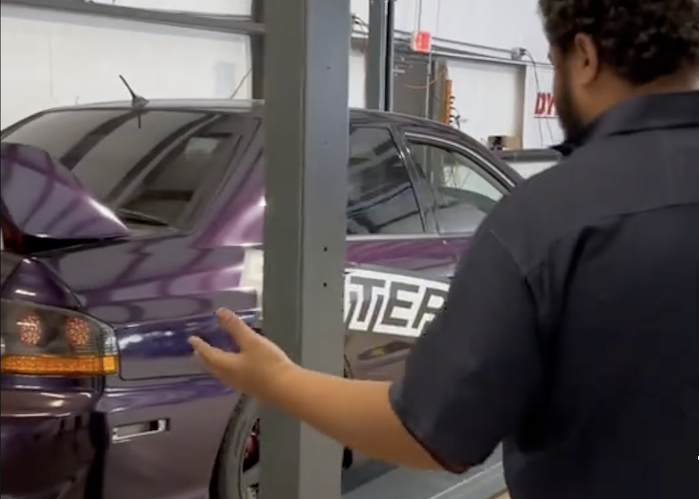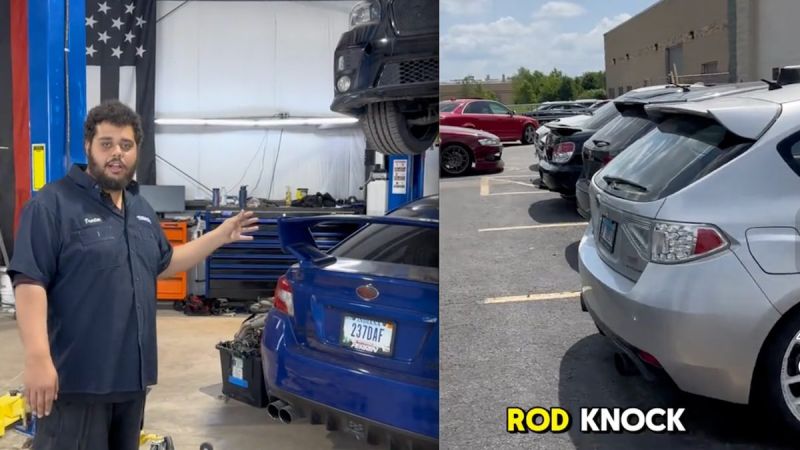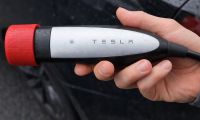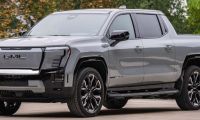Teter Auto, a renowned performance shop in North Aurora, Illinois, is well-versed in the realm of performance and Subaru's engine issues.
Trenton, a technician at Teter Auto (@teterautomotive), is taking a tour of the cars that are there due to engine problems. They work on all performance cars, BMW, Mercedes-Benz, Chevrolet Camaro, Chevy Corvette, and any vehicle that wants to get a performance upgrade.
In his TikTok clip, he walks through the outside lot and then enters the shop, and most of the cars present are Subaru WRX and STI performance models. Why are there so many Subarus there?
As Trenton walked the lot and then went inside the shop, I counted thirteen Subaru WRX and STIs that were in the shop for serious engine issues. All were there because of "rod knocks," which indicate the sound is originating from the engine's connecting rod bearings, typically caused by a lack of lubrication or excessive wear.
This is a serious situation where the connecting rod is in direct contact with the crankshaft, potentially leading to catastrophic engine damage if not addressed promptly. However, all the cars Trenton has in the shop are there because it's too late.
These engines are toast.
Here is what Trenton says as he checks out the cars that are there that day.
He says, "I don't know how many cars are here today and what their problems are, but let's take a look."
I can hear him saying, "All the cars in the shop are Subaru WRX and STIs with serious rod knock problems. These Engines Are Blown."
All are Subaru performance cars.
He walks through the lot, and it's full of Subaru WRX and STIs. This one has a hole in the block; this one has a rod knock; this one is also a rod knock, and that one has no oil in it."

He keeps walking through the lot full of Subaru WRX and STIs. He sees a GTO; that one is also a rod knock.
"This red STI is a rod knock," then he sees a Subaru Forester, "This one I don't remember. He looks at another STI, another rod knock."
He checks out an older STI hatch, "This one came in for a turbo build, but it started with another rod knock."
He looks at an older 2003 WRX, "This one has no oil in it."
He opens the hood of a white 2022 WRX with the engine that was just put back in after a rebuild and says, "It needs a first start-up."
"Here is an older Mercedes SL80 trying to act like a Subaru; it has a rod knock. There is an Audi out there; it has a bad head gasket, like a Subaru."
Surprised, he smiles and says about a 1996 Subaru Legacy RS, "I think this one actually runs."
What Car Does Trenton Own?
He walks into the shop and says, "Let's go inside. Here is my personal car," and points to a Mitsubishi Lancer EVO with white "Teter-Bilt" letters across the side.

He keeps walking through the shop and sees a blue 2003 Subaru WRX. "This one came in for a twin-turbo setup; this one doesn't have a rod knock."
"The black STI there; that was another rod knock."
Advertising "This blue STI is the only car that came in actually running. This car belongs to Thomas Phillips. He says with surprise in his voice, "The only one that came in running. Because he took this car and rebuilt it because it had a rod knock."
He points to a blue 2004 Subaru WRX that is being built from the ground up. "This one blew up. Not the engine, but the car itself blew up."
Why do so many Subaru WRX and STI engines have a rod knock?
Subaru WRX and STI engines are known to be susceptible to "rod knock," which is often attributed to a combination of factors, including the engine's design, oiling system limitations, and driving habits. The boxer engine's design, while providing a low center of gravity, can lead to challenges in oil circulation, particularly under high-performance conditions.
Specifically, the small oil capacity, combined with increased blow-by from turbocharged engines, can lead to oil contamination and a reduced oil film on the bearings, causing them to wear prematurely and potentially spin, which can result in rod knock and engine failure.
Here's a more detailed breakdown:
- Oiling System: Subaru's EJ series engines, found in many WRX and STI models, have a relatively small oil capacity. This, coupled with the boxer engine's design, can make it harder for oil to return to the pan, potentially leading to oil starvation and overheating, particularly during spirited driving or track use.
- Blow-by and Oil Contamination: Turbocharged engines, such as those in the WRX STI, produce more blow-by (combustion gases escaping past the piston rings), which contaminates the oil with combustion byproducts. This contaminated oil can accelerate bearing wear.
- Bearing Design: The relatively small size of the rod bearings in Subaru engines makes them more vulnerable to wear, especially when combined with oil contamination and high cylinder pressures.
- Driving Habits: Aggressive driving styles, such as frequent hard accelerations and high RPMs, can exacerbate the issues mentioned above, increasing the risk of rod knock. Improper tuning, especially with aftermarket modifications, can also put extra stress on the engine and bearings.
- Rod Bolt Stresses: In some cases, rod knock can be caused by stretched or damaged rod bolts, which can lead to bearing failure. This can occur due to excessive torque or rapid changes in torque.
What Can WRX and STI Owners Do To Mitigate the Risk of Rod Knock?
Frequent Oil Changes:
- Regular oil changes with high-quality synthetic oil are crucial to minimize the impact of oil contamination. How often should you change the oil?
- Subaru recommends changing the oil every 6,000 miles or 6 months. However, for those who drive in "severe conditions" (e.g., heavy traffic, frequent short trips, hard acceleration, high rpms), an oil change every 3,000 to 5,000 miles may be necessary if you want your engine to last.
Oil Analysis:
Shops like Teter Auto can perform an oil analysis, which can help detect early signs of bearing wear.
Oil System Upgrades:
Some WRX and STI owners upgrade to larger oil pans, windage trays, and oil pickups to improve oil flow and reduce the risk of starvation.
Tuning:
Proper tuning, especially after modifications, is crucial to ensure the engine operates within safe parameters.
Driving Style:
Subaru WRX and STI owners bought the cars because they are high-performance vehicles. However, adopting a more measured driving style, particularly during warm-up and under high rpms, can reduce stress on the engine.
Conclusion:
There's a reason why most of the cars sitting in the Teter Auto shop have rod knock engine issues, and they are typically Subaru WRXs and STIs. They are driven hard, not properly maintained with frequent oil changes, and they are abused.
However, Subaru EJ engines, particularly the EJ25 and EJ20 models, have a history of specific common problems. These include head gasket failures, ringland failures, excessive oil consumption, and timing belt and water pump issues. Additionally, some EJ20 models can experience overheating in cylinder four, which may lead to rod knock and necessitate an engine rebuild.
We Want To Hear From WRX and STI Owners
Do you own a Subaru WRX or STI? Have you experienced a rod knock in your engine and had to have it repaired? If so, click the red Add New Comment link below and let us know.
Check out my Subaru WRX STI story: Subaru Settles WRX/STI 2.5L Engine Lawsuit Following Months of Discovery
I am Denis Flierl, a Senior Torque News Reporter since 2012. My 30+ year tenure in the automotive industry, initially in a consulting role with every major car brand and later as a freelance journalist test-driving new vehicles, has equipped me with a wealth of knowledge. I specialize in reporting the latest automotive news and providing expert analysis on Subaru, which you'll find here, ensuring that you, as a reader, are always well-informed and up-to-date. Follow me on my X SubaruReport, All Subaru, WRXSTI, @DenisFlierl, Facebook, and Instagram.
Photo credit: Denis Flierl via Teter Auto













Comments
Nothing sounds like a Subaru…
Permalink
Nothing sounds like a Subaru boxer engine, like a large lawnmower with a failing muffler.